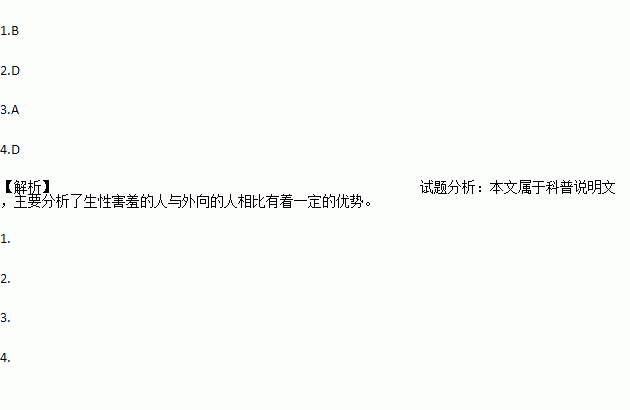题目内容
It’s rare that you see the words “shyness” and “letter” in the same sentence.After all,the common viewpoint is that those outgoing and sociable guys make great public speakers and excellent networkers and that those shy people are not.A survey conducted by USA Today referred to 65 percent of executives who believed shyness to be a barrier to leadership.Interestingly,the same article stresses that roughly 40 percent of leaders actually are quite shy—they're just better at adapting themselves to situational demands.Bill Gates,Warren Buffet and Charles Schwab are just a few "innies".
Unlike their outgoing counterparts who are more sensitive to rewards and risk-taking,shy people take a cautious approach to chance.Rather than the flashy chit-chat that defines social gathering,shy people listen attentively to what others say and absorb it before they speak.They're not thinking about what to say while the other person is still talking,but rather listening so they can learn what to say.Along the same lines,shy people share a common love of learning.They are intrinsically(内在地) motivated and therefore seek content regardless of achieving an outside standard.
Being shy can also bring other benefits.Remember being in school and hearing the same kids contribute,until shy little Johnny,who almost never said a word,cut in?Then what happened? Everyone turned around to look with great respect at little Johnny actually talking.This is how shy people made good use of their power of presence: they "own" the moment by speaking calmly and purposefully,which translate to a positive image.
Shyness is often related to modesty.Not to say that limelight-seekers aren't modest,but shy people tend to have an accurate sense of their abilities and achievements.As a result,they are able to acknowledge mistakes,imperfections, knowledge gaps and limitations.
Since shy people have a lower sensitivity to outside rewards than outgoing ones,they're more comfortable working with little information and sticking to their inner desires.Shy people are also more likely to insist on finding solutions that aren't primarily apparent.Don't believe me?Maybe you'll believe Albert Einstein,who once said,"It's not that I'm so smart,it's that I stay with problems longer."Obviously,finding certainty where uncertainty is typically popular is a huge plus for any successful person.
The myth that shy people are less effective leaders than their outgoing fellows is just a misunderstanding.Make wise use of your personality strengths to lead your business no matter what side of the range you fall on.
1.We can learn from Paragraph 2 that_______.
A. shy people are sensitive to rewards
B. shy people care more about content
C. outgoing people are more careful about chances
D. outgoing people consider what to learn while listening
2.The example of Johnny shows______.
A. shy people are likely to be modest
B. hardworking students speak little in public
C. some students keep silent on purpose at school
D. shy people may have an advantage in discussion
3.We can learn from the underlined sentence in Paragraph 5 that______.
A. shyness results in success
B. shyness contributes to popularity
C. outside reward leads to insistence
D. uncertainty counts more than certainty
4.The author supports his ideas mainly by______.
A. giving definitions and presenting research results
B. explaining problems and providing solutions
C. quoting authorities and making evaluations
D. making contrasts and gibing examples
 同步练习强化拓展系列答案
同步练习强化拓展系列答案

 office
office